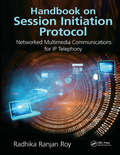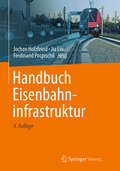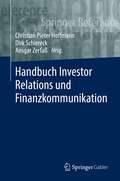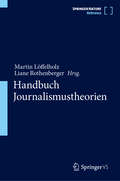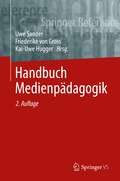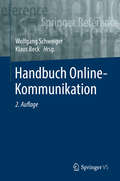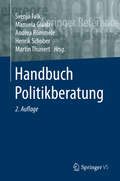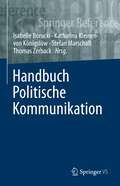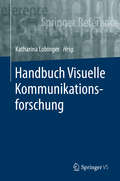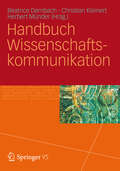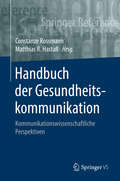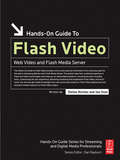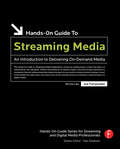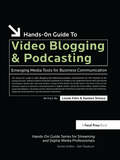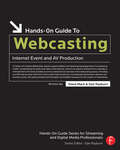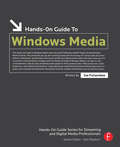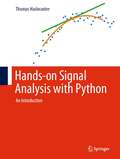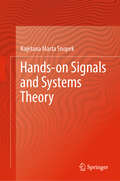- Table View
- List View
Handbook on Session Initiation Protocol: Networked Multimedia Communications for IP Telephony
by Radhika Ranjan RoySession Initiation Protocol (SIP), standardized by the Internet Engineering Task Force (IETF), has emulated the simplicity of the protocol architecture of hypertext transfer protocol (HTTP) and is being popularized for VoIP over the Internet because of the ease with which it can be meshed with web services. However, it is difficult to know exactly how many requests for comments (RFCs) have been published over the last two decades in regards to SIP or how those RFCs are interrelated. Handbook on Session Initiation Protocol: Networked Multimedia Communications for IP Telephony solves that problem. It is the first book to put together all SIP-related RFCs, with their mandatory and optional texts, in a chronological and systematic way so that it can be used as a single super-SIP RFC with an almost one-to-one integrity from beginning to end, allowing you to see the big picture of SIP for the basic SIP functionalities. It is a book that network designers, software developers, product manufacturers, implementers, interoperability testers, professionals, professors, and researchers will find to be very useful. The text of each RFC from the IETF has been reviewed by all members of a given working group made up of world-renowned experts, and a rough consensus made on which parts of the drafts need to be mandatory and optional, including whether an RFC needs to be Standards Track, Informational, or Experimental. Texts, ABNF syntaxes, figures, tables, and references are included in their original form. All RFCs, along with their authors, are provided as references. The book is organized into twenty chapters based on the major functionalities, features, and capabilities of SIP.
Handbuch Brettspiele: Tätigkeiten und Akteure in der Brettspielbranche
by Jürgen Karla Christoph PostIm Rahmen einer Podcast-Reihe im Jahr 2021 wurde die Entstehung eines Brettspiels - Von der Idee zum fertigen Produkt betrachtet. Im Rahmen dieses Herausgeberbandes erfolgt nun eine schriftliche Dokumentation durch Expertinnen und Experten aus der Brettspielbranche. Einleitend erfolgt eine Darstellung der Branche und der Branchenstrukturen orientiert an den Netzwerkstrukturen moderner Wertschöpfung. Bekannte Autorinnen und Autoren erläutern Ihre Vorgehensweisen zur Entwicklung von Brettspiel-Ideen und deren Weiterleitung an die Redaktionen in Verlagen. Führende Experten aus verschiedensten Aufgabengebieten in Verlagen stellen Ihre Aufgabenbereiche vor und erläutern die Prozesse in der Entstehung von Brettspielen (Redaktion, Illustration, Grafik, Lokalisierung, Lizenzierung). Der Produktionsprozess wird ausgehend von der Kalkulation, über den Einkauf, unterschiedliche Materialkomponenten, die Produktionsstätten bis zu Qualitätssicherung und Produktsicherheit. Unterschiedliche Vertriebswege für Brettspiele werden ebenso betrachtet wie die Medien- und Kommunikationsarbeit in Verlagen. Es erfolgt eine Betrachtung der verschiedenen Mediensegmente, über die Inhalte mit Brettspiel-Bezug rezipiert werden, sowie eine Betrachtung der für die Branche relevanten Auszeichnungen. Der Betrachtung des Kulturguts Brettspiel aus verschiedenen Blickwinkeln ist die abschließende Sektion dieses Buches gewidmet. Das Handbuch ist nicht nur für Brancheninsider von Interesse, sondern auch für Brettspielfans, die einen tieferen Einblick in das Hobby gewinnen möchten.
Handbuch Eisenbahninfrastruktur
by Jia Liu Jochen Holzfeind Ferdinand PospischilDie Eisenbahninfrastruktur weist eine große Anlagenvielfalt mit komplexen Wechselwirkungen auf. Diese Bandbreite und Komplexität von Bahnanlagen spiegelt das Nachschlagewerk mit Beiträgen von mehr als 50 Fachkräften aus allen Bereichen der Eisenbahninfrastruktur aus Deutschland und Österreich wider. Das Handbuch zeigt den erreichten Stand der Technik und berücksichtigt aktuelle Vorschriften. In den einzelnen miteinander vernetzten Kapiteln werden die technischen und operativen Grundlagen und Zusammenhänge der Eisenbahninfrastruktur sowie der Interaktion von Infrastruktur und Fahrzeug in Maß und Zahl dargestellt. Trassierung und Gleisplangestaltung, Eisenbahnoberbau, Kabelanlagen, Sicherheit, Instandhaltung und Anlagenmanagement sind nur einige der behandelten Fachgebiete. Die knappe aber fakten- und detailreiche Darstellung mit Bildern, Zeichnungen, Diagrammen und Tabellen ermöglicht einen schnellen Zugriff auf das gesuchte Wissensgebiet und die nachzuschlagenden Einzelheiten. Querverweise unterstützen das Verständnis der Komplexität und engen Vernetzung der verschiedenen Ingenieursdisziplinen auf dem Gebiet der Eisenbahninfrastruktur.Das Handbuch richtet sich an praktisch tätige Ingenieur*innen, Planungs- und Consultingingenieur*innen sowie an Führungskräfte und Entscheidungsträger in Unternehmen des Bahnsektors. Darüber hinaus eignet sich das Buch als umfassendes Nachschlagewerk für Studierende und Lehrende in Studiengängen des Verkehrs- und Bauingenieurwesens.
Handbuch Investor Relations und Finanzkommunikation
by Dirk Schiereck Christian Pieter Hoffmann Ansgar ZerfaßDas deutschsprachige Standardwerk zur Kapitalmarktkommunikation bietet einen Überblick zum aktuellen Stand der internationalen Forschung und zur Praxis in diesem jungen und dynamischen Themenfeld. Zugleich dient es als Lektüre für Verantwortungsträger in Vorstand, Geschäftsführung und anderen Funktionen, in Fachbereichen für Investor Relations, Unternehmenskommunikation und Marketing sowie für am Berufsfeld interessierte Studierende. Die Beiträge erläutern zunächst Grundlagen wie regulatorische Erfordernisse, Ansätze der Unternehmensbewertung oder Herausforderungen des Börsengangs. Einen Schwerpunkt bilden die strategische Planung, Organisation, Umsetzung, Instrumente und Evaluation von Investor Relations und Finanzkommunikation. Aufgaben wie die Entwicklung einer Equity Story werden ebenso erklärt wie das Aktienmarketing oder die Unternehmensberichterstattung. Abschließend werden besonders bedeutsame Handlungsfelder wie die Krisenkommunikation, die Kommunikation des Finanzvorstandes oder der Umgang mit aktivistischen Aktionären diskutiert. Das Handbuch verbindet kommunikationswissenschaftliche mit betriebswirtschaftlichen Perspektiven und Erkenntnissen aus den Disziplinen Finance und Accounting.
Handbuch Journalismustheorien
by Martin Löffelholz Liane RothenbergerDie aktualisierte, neu strukturierte und um 19 Originalbeiträge ergänzte Neuauflage des Handbuchs Journalismustheorien liefert einen systematischen und detaillierten Überblick über die theoretischen Ansätze der Journalismusforschung. Zehn thematische Abschnitte ermöglichen schnelle Einstiege in die jeweiligen Theorienkomplexe und schaffen eine verständliche Orientierung über die Grundlagen, Entwicklungsstränge, Konzepte und Problemfelder der Journalismustheorien sowie darüber hinaus zu theoretischen Ansätzen zu Interrelationen des Journalismus mit Bereichen wie Kultur, Politik, Religion, Sport, Wirtschaft oder Wissenschaft. Für Studierende und Forschende der Journalistik, der Kommunikationswissenschaft und angrenzender Disziplinen bildet das Handbuch ein Standardwerk zum Verständnis des komplexen wissenschaftlichen Diskurses über die theoretischen Ansätze der Journalismusforschung.
Handbuch Medien und Geschlecht: Perspektiven und Befunde der feministischen Kommunikations- und Medienforschung
by Brigitte Hipfl Johanna Dorer Brigitte Geiger Viktorija RatkovićDer Band bietet einen systematischen Überblick über die Grundlagen, Theorien und empirischen Befunde der feministischen Kommunikations- und Medienwissenschaft. Die Beiträge behandeln die Entwicklungen und den aktuellen Stand der gesamten Breite der kommunikationswissenschaftlichen Geschlechterforschung: Informations- und Unterhaltungsangebote der Medien, Fernseh- und Filmgenres, Social Media, Journalismus, Werbung, Öffentlichkeitsarbeit, Medienpolitik, Medienpädagogik, Medienpsychologie und Medienethik aus Geschlechterperspektive werden ebenso systematisch dargestellt wie die Themen der Frauenbewegung, Gewalt, Körper- und Sexualitätsdiskurse in Medien.
Handbuch Medienpädagogik
by Uwe Sander Kai-Uwe Hugger Friederike Von GrossDas Handbuch Medienpädagogik liefert Studierenden, pädagogischen Praktikern und Wissenschaftlern einen fundierten und systematisch aufgebauten Überblick über Theorie, Forschung, Geschichte, gegenwärtige Diskussionspunkte und Handlungsfelder der noch verhältnismäßig jungen erziehungswissenschaftlichen Teildisziplin Medienpädagogik. Unterschiedliche Expertinnen und Experten behandeln Strömungen und Theorien der Medienpädagogik, Methoden und Richtungen der Medienforschung sowie den Zusammenhang von Medienentwicklung und Medienpädagogik. Weiterhin werden Aufgaben und Handlungsfelder sowie berufliche und professionelle Aspekte der Medienpädagogik diskutiert.
Handbuch Medienökonomie
by Jan Krone Tassilo PellegriniDas Handbuch hat den Anspruch, die Medienökonomie vor dem Hintergrund der voranschreitenden Digitalisierung von Kommunikation, Medienproduktion, Medienvertrieb sowie der Anpassung ordnungspolitischer Rahmenbedingungen aus unterschiedlichen disziplinären Zugängen in seiner Gesamtheit abzubilden.
Handbuch Mitarbeiterkommunikation: Interne Kommunikation in Unternehmen
by Ansgar Zerfaß Sonja Sackmann Sabine EinwillerDas Handbuch vermittelt einen ganzheitlichen Überblick zu Mitarbeitenden als Zielgruppe und Akteure der Kommunikation von Unternehmen und anderen Organisationen. Diskutiert werden verschiedene Ebenen der internen Kommunikation: Interne Unternehmenskommunikation zwischen Unternehmensleitung und Mitarbeitenden sowie Führungskräften, Teamkommunikation, Führungskommunikation und informelle Mitarbeiterkommunikation. Daneben werden relevante Schnittstellen und Themen der externen Kommunikation adressiert wie Employer Branding und Arbeitgeberkommunikation. Kennzeichnend ist die interdisziplinäre Verknüpfung der Perspektiven von Kommunikationswissenschaft, Betriebswirtschaftslehre und Psychologie sowie die konsequente Orientierung an Herausforderungen der Unternehmensführung in der digitalen und globalisierten Gesellschaft. Das Handbuch richtet sich an Interessierte aus der Wissenschaft, Praxis sowie an Studierende aus den genannten Bereichen und angrenzenden Fachgebieten.
Handbuch Online-Kommunikation
by Klaus Beck Wolfgang SchweigerDas Handbuch gibt in 23 Beiträgen einschlägiger FachautorInnen einen umfassenden und systematischen Überblick des aktuellen Forschungsstandes kommunikationswissenschaftlicher Online-Forschung. Einführend werden die zentralen Fragestellungen, theoretischen Ansätze und empirischen Befunde dargestellt. Das Themenspektrum reicht von den Grundlagen computervermittelter Kommunikation (interpersonale, Gruppen- und öffentliche Kommunikation), über ökonomische, ethische und politische Fragen wie Regulierung und Kontrolle des Internets, sowie seine Verbreitung, Nutzung und Wirkung. Weitere Beiträge befassen sich mit Öffentlichkeit und Journalismus online, kulturellen und sozialpsychologischen Aspekten, Online-Werbung und -PR, Gesundheitskommunikation, E-Learning und Wissensmanagement sowie Online-Spielen. Ein Überblick über Methoden der Online-Forschung sowie die wichtigsten Datenquellen und Standarduntersuchungen rundet das Werk ab.
Handbuch Politikberatung
by Manuela Glaab Andrea Römmele Svenja Falk Henrik Schober Martin ThunertPolitik braucht Beratung und der Bedarf wächst. In diesem Handbuch werden daher relevante Felder der Politikberatung systematisch dargestellt, neue Entwicklungen analysiert und aktuelle Trends aufgezeigt. Neben den Grundlagen, Strukturen und Akteuren sowie den Feldern von Politikberatung finden erstmals deren Methoden und Instrumente differenziert Berücksichtigung.
Handbuch Politische Kommunikation
by Thomas Zerback Isabelle Borucki Stefan Marschall Katharina Kleinen-von KönigslöwAngesichts von Globalisierung, Individualisierung und Digitalisierung haben sich die Umwelten, Bedingungen und Folgen politischer Kommunikation fundamental gewandelt. Das stellt auch die Erforschung der politischen Kommunikation vor neue Herausforderungen. Diese schlagen sich in der Theorieentwicklung, in den Themen der Forschung, aber vor allem auch im methodischen Zugriff nieder. Angesichts dieses umfassenden Wandels bietet das Handbuch zum einen eine aktuelle Bestandsaufnahme der Forschung zur politischen Kommunikation. Neben dem State of the art will es zum anderen Entwicklungstrends der kommenden Jahre, insbesondere im Lichte der Digitalisierung, herauszeichnen und dabei diskutieren, wie die Forschung darauf reagieren kann.Das Handbuch ist konsequent interdisziplinär angelegt, es wird von Vertreter:innen der Kommunikationswissenschaft und der Politikwissenschaft gemeinsam herausgegeben. Die Autorinnen und Autoren der Beiträge stammen ebenfalls aus beiden Disziplinen. Auch in der thematischen Abdeckung berücksichtigt das Handbuch die beiden Perspektiven und schlägt darüber hinaus Brücken zu verwandten Forschungsbereichen, unter anderem zur Psychologie, Soziologie, Staatswissenschaft sowie Informatik.
Handbuch Public Affairs: Politische Kommunikation für Unternehmen und Organisationen
by Ulrike Röttger Ansgar Zerfaß Patrick DongesDas Handbuch bietet einen umfassenden Überblick über die Grundlagen, Rahmenbedingungen, Einsatzfelder, Instrumente und Maßnahmen des Public-Affairs-Managements. Es vermittelt grundlegendes Know-how über die Funktionsweisen, Potenziale und auch Risiken strategischer Kommunikation, die auf das politisch-administrative System und das gesellschaftspolitische Organisationsumfeld ausgerichtet ist. Die interdisziplinäre Herangehensweise des Handbuchs berücksichtigt zum einen Erkenntnisse aus unterschiedlichen wissenschaftlichen Disziplinen wie z.B. der Kommunikationswissenschaft, der Politikwissenschaft, der Rechtswissenschaft und der Betriebswirtschaftslehre. Zum anderen wird die Vertretung und Klärung von Interessen aus unterschiedlichen Praxisperspektiven beleuchtet – so etwa aus Sicht von Unternehmen, Politikerinnen und Politikern, Behörden, Interessenorganisationen und auch Public-Affairs-Dienstleistern. Das Handbuch richtet sich an Interessierte aus Wissenschaft und Praxis sowie an Studierende aus den genannten Bereichen und angrenzenden Fachgebieten.
Handbuch Soziale Medien
by Jan-Hinrik Schmidt Monika TaddickenSoziale Medien erleichtern es Menschen, Informationen aller Art zu teilen und soziale Beziehungen zu pflegen. Sie sind in den letzten Jahren und Jahrzehnten zu einem wesentlichen Bestandteil der digitalen Kommunikation geworden und verändern die Strukturen gesellschaftlicher Öffentlichkeit, aber auch den alltäglichen Austausch über privat-persönliche Themen. Ihre kommunikative Architektur nährt Hoffnungen auf verbesserte gesellschaftliche Partizipation genauso wie Befürchtungen, immer mehr Bereiche des Lebens würden kommerzialisiert und überwacht. Das Handbuch bereitet den aktuellen Forschungs- und Diskussionsstand zu Nutzung, gesellschaftlicher Einbettung und Folgen der sozialen Medien aus der Kommunikationswissenschaft und den angrenzenden Sozialwissenschaften auf. Für die zweite Auflage wurden die Beiträge überarbeitet und aktualisiert sowie das Handbuch um neue Beiträge ergänzt.
Handbuch Unternehmenskommunikation: Strategie – Management – Wertschöpfung (Springer Nachschlagewissen Ser.)
by Ulrike Röttger Ansgar Zerfaß Manfred PiwingerDie dritte Auflage des deutschsprachigen Standardwerks zur Unternehmenskommunikation zeigt, wie Kommunikation zum wirtschaftlichen Erfolg beiträgt, Handlungsspielräume schafft, Beziehungen aufbaut sowie Reputation und Unternehmenswert steigert. Im Mittelpunkt steht konzeptionelles Wissen, das Vorstand, Geschäftsführung und andere Führungskräfte benötigen, um zielführend mit Kommunikationsabteilungen und Agenturen zusammenzuarbeiten. Darüber hinaus erfahren Kommunikationsverantwortliche, Studierende und Wissenschaftler, wie man Kommunikation managen und Erfolgspotenziale aufbauen kann. Das Handbuch verbindet betriebswirtschaftliches Know-how mit kommunikationswissenschaftlichen Konzepten und Erfahrungen aus der Unternehmenspraxis. Grundbegriffe werden ebenso vermittelt wie neue Erkenntnisse zur digitalen Transformation, Agilität und Internationalisierung, zum Einsatz von Managementtools, Influencer- und CEO-Kommunikation, dem Alignment von Unternehmens- und Kommunikationszielen sowie den Merkmalen exzellenter Kommunikationsabteilungen.
Handbuch Visuelle Kommunikationsforschung
by Katharina LobingerDas Handbuch liefert einen umfassenden Einblick in zentrale Theorien, Forschungsfelder, Methoden und aktuelle Herausforderungen der Visuellen Kommunikationsforschung. Ziel ist es, einen State of the Art-Überblick über das dynamische Forschungsfeld zu geben, dabei traditionelle wie innovative Themenbereiche abzubilden, methodische Anleitungen zu geben und für kritische Aspekte der visuellen Forschung zu sensibilisieren.
Handbuch Wissenschaftskommunikation
by Herbert Münder Christian Kleinert Beatrice DernbachDer Band bietet einen Überblick über die Wissenschaftskommunikation unter vielen Perspektiven: Ausgehend von den politischen, ökonomischen und sozialen Rahmenbedingungen, unter denen Wissenschaft und Wissenschaftskommunikation stattfinden, werden die institutionellen Akteure auf nationaler und internationaler Ebene sowie Best-practice-Beispiele vorgestellt. Thematisiert werden ebenso die Perspektive der Wissenschaftskommunikation als Risiko- und Krisenkommunikation, das Verhältnis von Wissenschaftskommunikation zu Medien und Journalismus sowie die Evaluation von Wissenschaftskommunikation.
Handbuch der Gesundheitskommunikation: Kommunikationswissenschaftliche Perspektiven (Springer Reference Sozialwissenschaften Ser.)
by Constanze Rossmann Matthias R. HastallDas Handbuch gibt einen Überblick zum aktuellen Forschungsstand der Gesundheitskommunikation. Im Fokus stehen kommunikationswissenschaftliche Zugänge und Erkenntnisse sowie die Vorteile und Herausforderungen einer stärkeren Evidenzbasierung von Kommunikationsempfehlungen. Die Sektionen des Handbuchs reflektieren einerseits die zentralen Elemente des Kommunikationsprozesses und andererseits die wichtigsten Anwendungskontexte. Das Handbuch richtet sich an Studierende, Wissenschaftlerinnen und Wissenschaftler unterschiedlicher Disziplinen genauso wie an Expertinnen und Experten aus der Praxis.
Hands-On Guide to Flash Video: Web Video and Flash Media Server (Hands-on Guide Ser.)
by Stefan Richter Jan OzerThe Hands-On Guide to Flash Video is a professional reference book written by industry experts that are currently helping professionals produce Web video and implement Flash Media Server. This book covers Flash Video production from soup to nuts, beginning with how to configure your camcorder and ending to advanced server techniques like bandwidth detection and FMS logging and reporting. Real word lessons from case studies of successful Flash Video deployments are also included. Supplemental files located at: www.flashvideobook.comBy reading this book, you'll learn to:* Shoot high quality video for streaming* Choose the best encoder and encoding techniques for producing Flash Video* Deploy Flash Video via progressive download or via the Flash Media Server. * Create and light a compression friendly set* Deinterlace and preprocess your video prior to encoding* Choose encoding parameters like data rate, resolution and frame rate* Optimize encoding with Sorenson Squeeze, Flix Pro and the Adobe Flash Video Encoder* Shoot and produce chromakey video for alpha channel delivery* Customize a Flash player via skinning, and use Cue Points for navigation * Setup, install, and maintain Flash Media Server
Hands-On Guide to Streaming Media: an Introduction to Delivering On-Demand Media (Hands-on Guide Streaming Media Ser.)
by Joe FollansbeeThis book describes the steps for creating an on-demand and live streaming video in an all-in-one refernce guide for new users and companies that need introduced to the technology.After reading this book, you will understand:- How the Internet works in relation to streaming media- Client/server technology, specifically related to streaming media- Strengths and limits of streaming media, including best uses for the technology- Choices of streaming media content creation tools
Hands-On Guide to Video Blogging and Podcasting: Emerging Media Tools for Business Communication (Focal Hands-on Guide Ser.)
by Damien Stolarz Lionel FelixFor all of your video and audio blogging business and professional communication needs, this book is it!The Hands-on Guide to Video Blogging and Podcasting provides tremendous value to those content publishers, big and small, that want to create syndicated video blog and podcast content. The simplified, plain talking break-down the authors bring to the book will give everyone the tools to plan, create, and execute a blog/podcast outlet.This book explains these emerging media tools from a professional perspective. Quickly learn the technical aspects of video blogging and podcasting along with their business and financial ramifications.
Hands-On Guide to Webcasting: Internet Event and AV Production (Hands-on Guide Streaming Media Ser.)
by Dan Rayburn Steve MackIn "Hands-On Guide to Webcasting," industry experts address the fastest-growing application for streaming media - broadcasting live audio and video on the Internet. Used in all industry verticals from corporate to entertainment, this book provides an end-to-end technical overview of the webcasting process. Providing you with step-by-step instructions from audio/video production, encoding and authoring to delivery and business issues, this guide provides both the depth and breadth necessary for mastery of the subject.
Hands-On Guide to Windows Media (Hands-on Guide Streaming Media Ser.)
by Joe FollansbeeHands-On Guide to Windows Media is a practical guide that teaches how to distribute audio and video efficiently and effectively over computer networks. This book enables you to get up and running quickly and focuses on one of the most popular tools in the streaming media universe, Windows Media. This book will help you to understand the unique characteristics and demands of streaming audio and video information over packet-switched networks. Ideal even for non-technical readers.
Hands-on Signal Analysis with Python: An Introduction
by Thomas HaslwanterThis book provides the tools for analyzing data in Python: different types of filters are introduced and explained, such as FIR-, IIR- and morphological filters, as well as their application to one- and two-dimensional data. The required mathematics are kept to a minimum, and numerous examples and working Python programs are included for a quick start. The goal of the book is to enable also novice users to choose appropriate methods and to complete real-world tasks such as differentiation, integration, and smoothing of time series, or simple edge detection in images. An introductory section provides help and tips for getting Python installed and configured on your computer. More advanced chapters provide a practical introduction to the Fourier transform and its applications such as sound processing, as well as to the solution of equations of motion with the Laplace transform. A brief excursion into machine learning shows the powerful tools that are available with Python. This book also provides tips for an efficient programming work flow: from the use of a debugger for finding mistakes, code-versioning with git to avoid the loss of working programs, to the construction of graphical user interfaces (GUIs) for the visualization of data. Working, well-documented Python solutions are included for all exercises, and IPython/Jupyter notebooks provide additional help to get people started and outlooks for the interested reader.
Hands-on Signals and Systems Theory
by Kajetana Marta SnopekThis textbook presents the theory of continuous-time and discrete-time signals and systems and shows how it can be used to solve analytically different problems. The book is dedicated to engineering students who are interested in mathematical methods used to solve real technical problems connected with signals and systems. The book covers, both in continuous- and in discrete domains, analysis of signals in time domain; orthogonal signal representation including Fourier series; convolution and correlation of signals; analysis of signals in the frequency domain and signal sampling, including aliasing and stroboscopic effects, among others. The author also emphasizes the role of Fourier-, one-sided Laplace- and one-sided Z transformations in signals and systems. Chosen methods of analog and digital filter design and stability criteria of analog and digital filters are also described. The author presents the necessary theory in the form of a concise “lecture” accompanied with a number of solved original problems. Every chapter ends with examples of complete solutions with explanation and necessary graphical visualization (graphs, schemes etc.).
